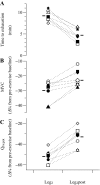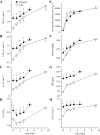Peripheral fatigue limits endurance exercise via a sensory feedback-mediated reduction in spinal motoneuronal output
- PMID: 23722705
- PMCID: PMC3743006
- DOI: 10.1152/japplphysiol.00049.2013
Peripheral fatigue limits endurance exercise via a sensory feedback-mediated reduction in spinal motoneuronal output
Abstract
This study sought to determine whether afferent feedback associated with peripheral muscle fatigue inhibits central motor drive (CMD) and thereby limits endurance exercise performance. On two separate days, eight men performed constant-load, single-leg knee extensor exercise to exhaustion (85% of peak power) with each leg (Leg1 and Leg2). On another day, the performance test was repeated with one leg (Leg1) and consecutively (within 10 s) with the other/contralateral leg (Leg2-post). Exercise-induced quadriceps fatigue was assessed by reductions in potentiated quadriceps twitch-force from pre- to postexercise (ΔQtw,pot) in response to supramaximal magnetic femoral nerve stimulation. The output from spinal motoneurons, estimated from quadriceps electromyography (iEMG), was used to reflect changes in CMD. Rating of perceived exertion (RPE) was recorded during exercise. Time to exhaustion (∼9.3 min) and exercise-induced ΔQtw,pot (∼51%) were similar in Leg1 and Leg2 (P > 0.5). In the consecutive leg trial, endurance performance of the first leg was similar to that observed during the initial trial (∼9.3 min; P = 0.8); however, time to exhaustion of the consecutively exercising contralateral leg (Leg2-post) was shorter than the initial Leg2 trial (4.7 ± 0.6 vs. 9.2 ± 0.4 min; P < 0.01). Additionally, ΔQtw,pot following Leg2-post was less than Leg2 (33 ± 3 vs 52 ± 3%; P < 0.01). Although the slope of iEMG was similar during Leg2 and Leg2-post, end-exercise iEMG following Leg2-post was 26% lower compared with Leg2 (P < 0.05). Despite a similar rate of rise, RPE was consistently ∼28% higher throughout Leg2-post vs. Leg2 (P < 0.05). In conclusion, this study provides evidence that peripheral fatigue and associated afferent feedback limits the development of peripheral fatigue and compromises endurance exercise performance by inhibiting CMD.
Keywords: central fatigue; central motor drive; group III and IV muscle afferents; neural feedback.
Figures






Comment in
-
The oxygen-conformer response and its contribution to task failure in exhaustive exercise.J Appl Physiol (1985). 2019 Mar 1;126(3):796. doi: 10.1152/japplphysiol.00888.2018. J Appl Physiol (1985). 2019. PMID: 30907708 No abstract available.
-
Reply to Drouin and Tschakovsky.J Appl Physiol (1985). 2019 Mar 1;126(3):797. doi: 10.1152/japplphysiol.00950.2018. J Appl Physiol (1985). 2019. PMID: 30907710 Free PMC article. No abstract available.
References
Publication types
MeSH terms
Substances
Grants and funding
LinkOut - more resources
Full Text Sources
Other Literature Sources
Medical
Miscellaneous

